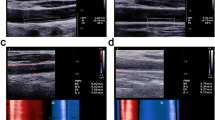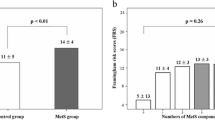Abstract
Objectives
To evaluate carotid stiffening in participants without conventional cardiovascular risk factors (CVRFs) by using ultrafast pulse wave velocity (ufPWV).
Methods
The present study enrolled 517 participants without conventional CVRFs (CVRF-Free total population). Subjects in this population were defined as current non-smokers with untreated blood pressure < 140/90 mmHg, fasting blood glucose (FBG) < 7.0 mmol/L, total cholesterol (TC) < 6.2 mmol/L, low-density lipoprotein cholesterol < 4.1 mmol/L, and high-density lipoprotein cholesterol ≥ 1.0 mmol/L. Participants in the subgroup with optimal CVRFs (CVRF-Optimal subgroup; n = 188) were defined as having blood pressure < 120/80 mmHg, TC < 5.2 mmol/L, and FBG < 5.6 mmol/L. Clinical interviews, physical examinations, serum draw, carotid intima-media thickness (cIMT), and ufPWV were evaluated. Adjusted odds ratios (ORs) with 95% confidence intervals and ordinal logistic regression models were used.
Results
Carotid stiffening was present in 46.2–54.5% of CVRF-Free subjects. Age, male sex, and body mass index (BMI) were independently associated with carotid stiffening in both the CVRF-Free total population and CVRF-Optimal subgroup (OR for age = 1.10–1.11, OR for male sex = 2.65–7.19, OR for BMI = 1.34–1.62; p < 0.05). Carotid stiffening was associated with TC only in the CVRF-Free total population (OR for TC = 1.84; p = 0.034).
Conclusions
Many CVRF-Free individuals have carotid stiffening. ufPWV for atherosclerotic stiffening aids the assessment of early atherogenesis and may further clarify the true status of healthy adults without CVRFs.
Key Points
• CVRF-Optimal individuals have a lower carotid stiffness than CVRF-Free populations.
• ufPWV is a quantitative predictor for the early assessment of AS.
• Absent major CVRFs cannot be considered low risk for carotid stiffening and atherosclerosis.






Similar content being viewed by others
Abbreviations
- ACAMS:
-
Aixplorer cIMT automatic measure system
- ALT:
-
Alanine aminotransferase
- AS:
-
Atherosclerosis
- BMI:
-
Body mass index
- CCA:
-
Common carotid artery
- cfPWV:
-
Carotid-femoral pulse wave velocity
- CI:
-
Confidence interval
- cIMT:
-
Carotid intima-media thickness
- CVRF:
-
Cardiovascular risk factor
- DBP:
-
Diastolic blood pressure
- DICOM:
-
Digital Imaging and Communications in Medicine
- eGFR:
-
Estimated glomerular filtration rate
- ESC:
-
European Society of Cardiology
- FBG:
-
Fasting blood glucose
- HDL:
-
High-density lipoprotein
- IMT:
-
Intima-media thickness
- LDL:
-
Low-density lipoprotein
- OR:
-
Odds ratio
- PESA:
-
Progression of Early Subclinical Atherosclerosis
- PWV:
-
Pulse wave velocity
- PWV-BS:
-
Pulse wave velocity-beginning of systole
- PWV-ES:
-
Pulse wave velocity-end of systole
- ROI:
-
Region of interest
- SBP:
-
Systolic blood pressure
- TC:
-
Total cholesterol
- TG:
-
Triglyceride
- ufPWV:
-
Ultrafast pulse wave velocity
- UUI:
-
Ultrafast ultrasound imaging
- vEDS:
-
Vascular Ehlers-Danlos syndrome
References
Khot UN, Khot MB, Bajzer CT et al (2003) Prevalence of conventional risk factors in patients with coronary heart disease. JAMA 290:898–904
George MG, Tong X, Bowman BA (2017) Prevalence of cardiovascular risk factors and strokes in younger adults. JAMA Neurol 74:695–703
Fernández-Friera L, Fuster V, López-Melgar B et al (2017) Normal LDL-cholesterol levels are associated with subclinical atherosclerosis in the absence of risk factors. J Am Coll Cardiol 70:2979–2991
Piepoli MF, Hoes AW, Agewall S et al (2016) 2016 European guidelines on cardiovascular disease prevention in clinical practice: the Sixth Joint Task Force of the European Society of Cardiology and other societies on cardiovascular disease prevention in clinical practice (constituted by representatives of 10 societies and by invited experts) developed with the special contribution of the European Association for Cardiovascular Prevention & Rehabilitation (EACPR). Atherosclerosis 252:207–274
Mancia G, Fagard R, Narkiewicz K et al (2013) 2013 ESH/ESC guidelines for the management of arterial hypertension: the Task Force for the Management of Arterial Hypertension of the European Society of Hypertension (ESH) and of the European Society of Cardiology (ESC). Eur Heart J 34:2159–2219
Baber U, Mehran R, Sartori S et al (2015) Prevalence, impact, and predictive value of detecting subclinical coronary and carotid atherosclerosis in asymptomatic adults: the BioImage study. J Am Coll Cardiol 65:1065–1074
Yeboah J, McClelland RL, Polonsky TS et al (2012) Comparison of novel risk markers for improvement in cardiovascular risk assessment in intermediate-risk individuals. JAMA 308:788–795
Gonzalez-Cantero A, Gonzalez-Cantero J, Sanchez-Moya AI, Rodriguez-Padial L, Perez-Hortet C, Gonzalez-Calvin JL (2019) Is intima-media thickness a predictor for cardiovascular risk? Lancet 394:380–381
Gepner AD, Young R, Delaney JA et al (2015) Comparison of coronary artery calcium presence, carotid plaque presence, and carotid intima-media thickness for cardiovascular disease prediction in the Multi-Ethnic Study of Atherosclerosis. Circ Cardiovasc Imaging 8:e002262
Den Ruijter HM, Peters SA, Anderson TJ et al (2012) Common carotid intima-media thickness measurements in cardiovascular risk prediction: a meta-analysis. JAMA 308:796–803
Lorenz MW, Polak JF, Kavousi M et al (2012) Carotid intima-media thickness progression to predict cardiovascular events in the general population (the PROG-IMT collaborative project): a meta-analysis of individual participant data. Lancet 379:2053–2062
Vlachopoulos C, Aznaouridis K, Stefanadis C (2010) Prediction of cardiovascular events and all-cause mortality with arterial stiffness: a systematic review and meta-analysis. J Am Coll Cardiol 55:1318–1327
Marais L, Pernot M, Khettab H et al (2019) Arterial stiffness assessment by shear wave elastography and ultrafast pulse wave imaging: comparison with reference techniques in normotensives and hypertensives. Ultrasound Med Biol 45:758–772
Mirault T, Pernot M, Frank M et al (2015) Carotid stiffness change over the cardiac cycle by ultrafast ultrasound imaging in healthy volunteers and vascular Ehlers-Danlos syndrome. J Hypertens 33:1890–1896
Li X, Jiang J, Zhang H et al (2007) Measurement of carotid pulse wave velocity using ultrafast ultrasound imaging in hypertensive patients. J Med Ultrason (2001) 44:183–190
Zhu ZQ, Chen LS, Wang H et al (2019) Carotid stiffness and atherosclerotic risk: non-invasive quantification with ultrafast ultrasound pulse wave velocity. Eur Radiol 29:1507–1517
Pan FS, Xu M, Yu L et al (2019) Relationship between carotid intima-media thickness and carotid artery stiffness assessed by ultrafast ultrasound imaging in patients with type 2 diabetes. Eur J Radiol 111:34–40
Pan FS, Yu L, Luo J et al (2018) Carotid artery stiffness assessment by ultrafast ultrasound imaging: feasibility and potential influencing factors. J Ultrasound Med 37:2759–2767
Levey AS, Stevens LA, Schmid CH et al (2009) A new equation to estimate glomerular filtration rate. Ann Intern Med 150:604–612
Touboul PJ, Hennerici MG, Meairs S et al (2004) Mannheim intima-media thickness consensus. Cerebrovasc Dis 18:346–349
Näslund U, Ng N, Lundgren A et al (2019) Visualization of asymptomatic atherosclerotic disease for optimum cardiovascular prevention (VIPVIZA): a pragmatic, open-label, randomised controlled trial. Lancet 393:133–142
Denissen SJ, van der Aalst CM, Vonder M, Oudkerk M, de Koning HJ (2019) Impact of a cardiovascular disease risk screening result on preventive behaviour in asymptomatic participants of the ROBINSCA trial. Eur J Prev Cardiol 26:1313–1322
El Jalbout R, Cloutier G, Roy-Cardinal MH et al (2019) The value of non-invasive vascular elastography (NIVE) in detecting early vascular changes in overweight and obese children. Eur Radiol 29:3854–3861
Roy Cardinal MH, Durand M, Chartrand-Lefebvre C et al (2020) Increased carotid artery wall stiffness and plaque prevalence in HIV infected patients measured with ultrasound elastography. Eur Radiol 30:3178–3187
Wang JC, Bennett M (2012) Aging and atherosclerosis: mechanisms, functional consequences, and potential therapeutics for cellular senescence. Circ Res 111:245–259
Yu XH, Zhang DW, Zheng XL, Tang CK (2019) Cholesterol transport system: an integrated cholesterol transport model involved in atherosclerosis. Prog Lipid Res 73:65–91
Reimann C, Brangsch J, Colletini F et al (2017) Molecular imaging of the extracellular matrix in the context of atherosclerosis. Adv Drug Deliv Rev 113:49–60
Bonnans C, Chou J, Werb Z (2014) Remodelling the extracellular matrix in development and disease. Nat Rev Mol Cell Biol 15:786–801
Ahmadi A, Argulian E, Leipsic J, Newby DE, Narula J (2019) From subclinical atherosclerosis to plaque progression and acute coronary events: JACC state-of-the-art review. J Am Coll Cardiol 74:1608–1617
Fernández-Friera L, Peñalvo JL, Fernández-Ortiz A et al (2015) Prevalence, vascular distribution, and multiterritorial extent of subclinical atherosclerosis in a middle-aged cohort: the PESA (Progression of Early Subclinical Atherosclerosis) study. Circulation 131:2104–2113
Kassi E, Spilioti E, Nasiri-Ansari N et al (2015) Vascular inflammation and atherosclerosis: the role of estrogen receptors. Curr Med Chem 22:2651–2665
Peters SAE, Muntner P, Woodward M (2019) Sex differences in the prevalence of, and trends in, cardiovascular risk factors, treatment, and control in the United States, 2001 to 2016. Circulation 139:1025–1035
Chen YC, Hsu BG, Lee CJ, Ho CC, Ho GJ, Lee MC (2018) Serum adipocyte fatty acid-binding protein level is associated with arterial stiffness quantified with cardio-ankle vascular index in kidney transplant patients. Clin Exp Nephrol 22:188–195
Tsiakou A, Liatis S, Alexiadou K et al (2013) Arterial stiffness is inversely related to plasma adiponectin levels in young normotensive patients with type 1 diabetes. Diabetes Care 36:734–736
Borén J, Chapman MJ, Krauss RM et al (2020) Low-density lipoproteins cause atherosclerotic cardiovascular disease: pathophysiological, genetic, and therapeutic insights: a consensus statement from the European Atherosclerosis Society Consensus Panel. Eur Heart J. https://doi.org/10.1093/eurheartj/ehz962
Funding
This work was supported by the National Natural Science Foundation of China (grant number: 81901756), the Team Project of Jiangsu Provincial Six Talent Peaks (grant number: TD-SWYY-069), the Key Project of Jiangsu Administration of Chinese Medicine (grant number: ZD201906), the Research Project of National Administration of Chinese Medicine (grant number: YB2015020), and the Research of Jiangsu Province Hospital of Chinese Medicine (grant number: Y20044).
Author information
Authors and Affiliations
Corresponding authors
Ethics declarations
Guarantor
The scientific guarantors of this publication are Hui Huang, M.D. (Department of Ultrasound, Affiliated Hospital of Nanjing University of Chinese Medicine, Jiangsu Province Hospital of Chinese Medicine, Nanjing, 210029, China) and Fu-Ming Liu, Ph.D. (Department of Cardiology, Affiliated Hospital of Nanjing University of Chinese Medicine, Jiangsu Province Hospital of Chinese Medicine, Nanjing, 210029, China).
Conflict of interest
The authors of this manuscript declare no relationships with any companies, whose products or services may be related to the subject matter of the article.
Statistics and biometry
No complex statistical methods were necessary for this paper.
Informed consent
Written informed consent was obtained from all subjects (patients) in this study.
Ethical approval
Institutional Review Board approval was obtained.
Methodology
• prospective
• diagnostic or prognostic study
• performed at one institution
Additional information
Publisher’s note
Springer Nature remains neutral with regard to jurisdictional claims in published maps and institutional affiliations.
Electronic supplementary material
ESM 1
(DOC 7902 kb)
Rights and permissions
About this article
Cite this article
Zhu, ZQ., Chen, LS., Jiang, XZ. et al. Absent atherosclerotic risk factors are associated with carotid stiffening quantified with ultrafast ultrasound imaging. Eur Radiol 31, 3195–3206 (2021). https://doi.org/10.1007/s00330-020-07405-4
Received:
Revised:
Accepted:
Published:
Issue Date:
DOI: https://doi.org/10.1007/s00330-020-07405-4




